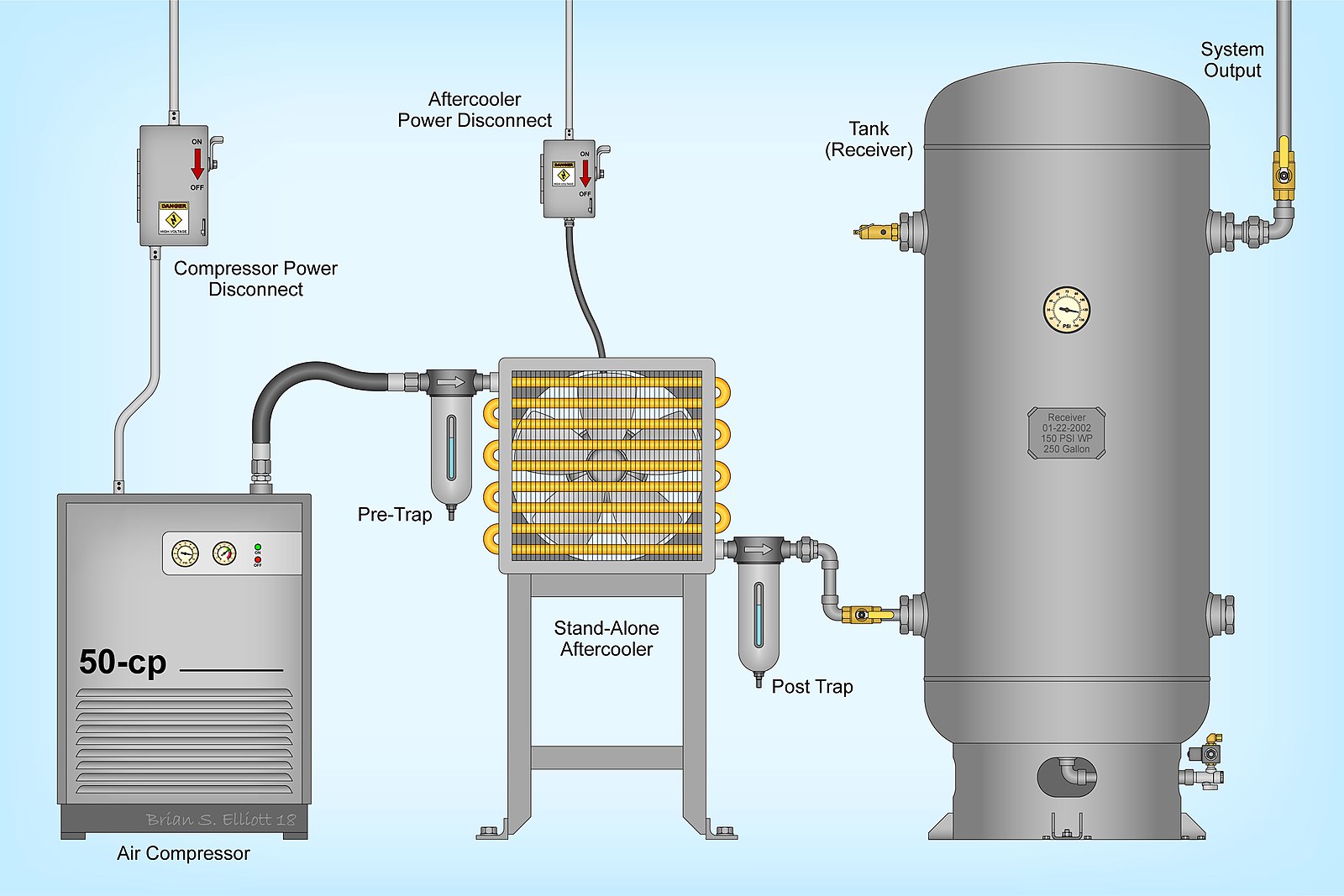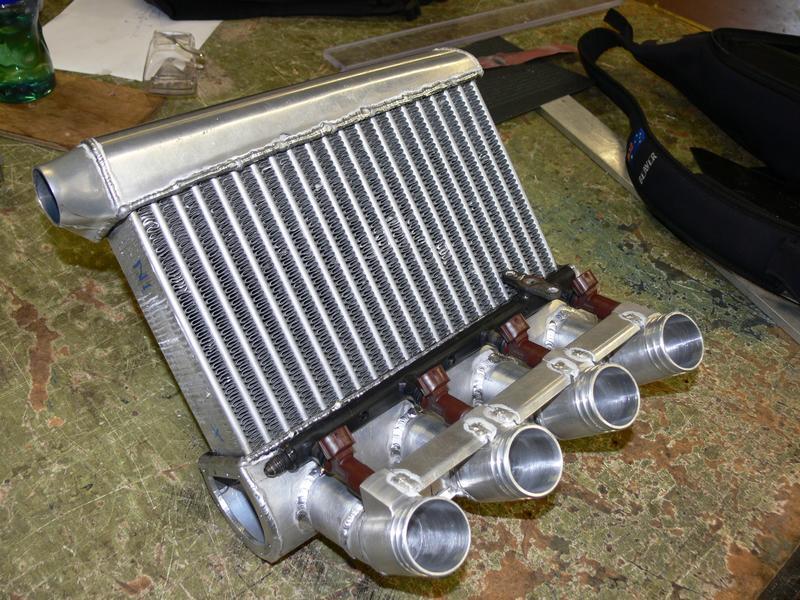Difference Between Aftercooler and Intercooler
Terminologies that sound similar can be very confusing, especially when they are frequently used interchangeably. Same is the case with two common terminologies used in the automotive circle: Aftercooler and Intercooler. In automotive terms, they refer to the heat exchangers used to cool the discharge from an air compressor. In general, they are both referred to as charge air coolers which are often used on turbocharged and supercharged internal combustion engines. The main function of the charge air cooler is to cool the air compressed by the turbocharger/supercharger before it enters the engine, eventually reducing it to a lower temperature and allowing more air to enter for increased fuel combustion.
Almost all industrial systems require aftercoolers. In some systems, aftercoolers are an integral part of the compressor package, while in many systems the aftercooler is a standalone piece of equipment. Some systems have both. The mechanical heat exchanger should be located as close as possible to the discharge of the compressor to cool the air to a lower temperature immediately after it is discharged from the compressor. An aftercooler is also called an intercooler or charge air cooler. They all refer to the mechanical device that sits between the turbocharger/supercharger and the engine and looks like a large radiator. Although, they basically serve the same purpose, an intercooler cools the air that has been compressed by either a supercharger or a turbocharger.
What is an Aftercooler?
An aftercooler is a mechanical heat exchanger that cools air to within 5-20 degrees Fahrenheit of ambient temperature as soon as it is discharged from the compressor. It is a mechanical device comprises of a series of tubes and fins, which uses ambient air to condense out moisture in the compressed air. It is a sophisticated air cooler installed at a point after air has been compressed. They are cooled by either air or water. Air-cooled aftercoolers are known as air-to-air and use ambient air to cool the hot compressed air. Water-cooled aftercoolers are known as air-to-water and use water to cool the air. Heat from the compressed air is transferred to the water and water vapor forms as the compressed air starts cooling. This results in better heat transfer with no electricity required.
What is an Intercooler?
An intercooler is a mechanical heat exchanger used in turbocharged engines to cool the compressed air back to the near ambient temperature to increase their volumetric efficiency. However, unlike an aftercooler, it cools the air compressed by the turbocharger/supercharger before it enters the engine, allowing more air to enter. It increases air density, which increased both efficiency of the engine and the maximum power output, for a given maximum intake pressure in both CI and SI engines. Turbocharged SI engines are more likely to experience premature ignition by either knocking or detonation, and intercoolers are mainly used for knock reduction. And when you cool the compressed air with an intercooler, you can add more without any detonation. When we talk about intercoolers in automobiles, we refer to the charge air cooler.
Difference between Aftercooler and Intercooler
Terminology of Aftercooler and Intercooler
– Both the terms aftercooler and intercooler are often used interchangeably and they basically serve the same purpose – to cool engine air before it enters an engine’s induction system. When used in automobiles, both the terms refer to the charge air cooler. It’s the most generic term for aftercoolers and intercoolers. It refers to a mechanical device that sits between the turbocharger/supercharger and the engine. Today, many people refer to intercoolers as aftercoolers, because they are located after the supercharger or turbocharger.
Working of Aftercooler vs. Intercooler
– An aftercooler is a heat exchanger used in turbocharged engines (after the compressor) to cool the compressed air off back to near ambient temperature as soon as it is discharged from the compressor. It uses ambient air to condense out moisture in the compressed air. This condensation process also helps to cool the air. An intercooler is a mechanical device used commonly on turbocharged and supercharged engines for intake air cooling. It cools air that has been compressed by either a turbocharger or a supercharger. It increases air density, which increases both the maximum power output and efficiency of the engine.
Applications
– Aftercoolers work really well in drag racing applications because they only need to work for short periods of time. A Vortech aftercooler is a popular air-to-water aftercooler used mostly in cars and trucks to cool the water via air-passing through the front grill. On the other hand, air-to-air intercoolers are far more practical for milder racing and street applications as they do not lose their ability to cool incoming air with time. Intercoolers of either type work only in conjunction with forced induction engines where there is a substantial difference in temperature between the air that enters the engine and the cooling medium.
Aftercooler vs. Intercooler: Comparison Chart
6 83″ src=”http://www.differencebetween.net/wp-content/uploads/2019/05/Aftercooler-vs-Intercooler.jpg” alt=”” width=”550″ height=”491″>
Summary of Aftercooler vs. Intercooler
In a nutshell, both aftercoolers and intercoolers refer to the mechanical device that sits between the turbocharger/supercharger and the engine and looks like a large radiator. An aftercooler is also called an intercooler or charge air cooler. The main function of the charge air cooler is to cool the air compressed by the turbocharger/supercharger before it enters the engine, eventually reducing it to a lower temperature and allowing more air to enter for increased fuel combustion. Although they both serve the same purpose, there is still some confusion in terminology between an aftercooler and an intercooler.
- Difference Between FTP and SFTP - April 16, 2024
- Difference Between El Nino and La Nina - April 13, 2024
- Difference Between an Arbitrator and a Mediator - April 11, 2024
Search DifferenceBetween.net :
Leave a Response
References :
[0]Gilles, Tim. Automotive Service: Inspection, Maintenance, Repair. Boston, Massachusetts: Cengage, 2015. Print
[1]Gupta, A.K and S.K Arora. Industrial Automation and Robotics. New Delhi, India: Laxmi Publications, 2009. Print
[2]Eriksson, Lars and Lars Nielson. Modeling and Control of Engines and Drivelines. Hoboken, New Jersey: John Wiley & Sons, 2014. Print
[3]Image credit: https://commons.wikimedia.org/wiki/File:Aftercooler-Stand-Alone.jpg
[4]Image credit: https://ca.wikipedia.org/wiki/Fitxer:Intercooler-2_Stage_system.jpg


